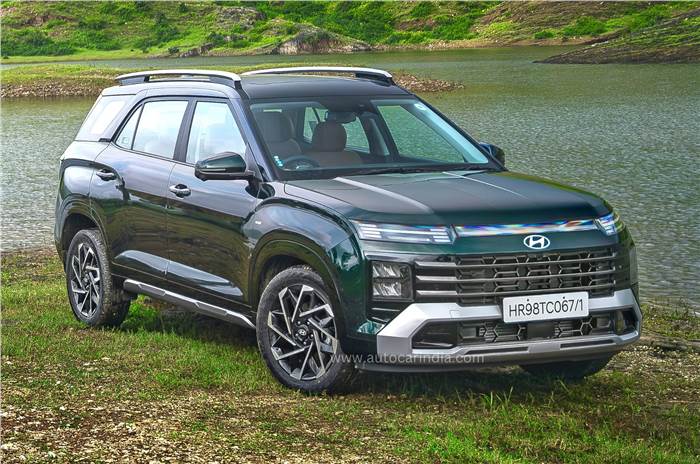Hyundai ensures that every model’s life-cycle management is taken care of, and no product is long in the tooth. We’ve seen it with the Verna, the Venue, the Creta and now, the Alcazar. The Alcazar was always the Creta with a third row. It was meant for someone who wants a bit more practicality, wants to occasionally ferry a few more passengers, and do so without compromising on tech and features. For 2024, it has been updated with a refreshed look, fresh interior and even more tech and features.
Hyundai Alcazar facelift exterior

Similarities to the Creta are obvious, but there are subtle differences.
In terms of design, the refreshed SUV sports Hyundai’s new design language that is similar to the Creta. However, the subtle differences are the H-pattern Daytime Running Lamps (DRL), while a new grille and new front bumper with a silver skid plate give it a butch look. Over to the side, the 18-inch alloy wheels look sharp, and it even gets functional roof rails. The body lines, however, are carried over from the previous car and there are no changes to the dimensions. At the rear, the vertical LED tail-lamps form an H with the extended LED DRL bar. The bumper and tailgate get the same silver finish as the front. For those who like the discretion of matte paint, the brand has also introduced a Titan Gray Matte option. Safe to say that with the facelift, the Alcazar does seem more mature and will appeal to a lot more buyers compared to the older model.
Hyundai Alcazar facelift interior

The first thing that jumps at you inside the updated Alcazar is the dashboard’s beige and navy blue color combination. That said, the layout is similar to the Creta with the two 10.25-inch screens – one for the instrument cluster and the other for the touchscreen. In typical Hyundai fashion, the touchscreen is loaded with features and the UI is very well sorted and easy to use. But what’s a strange miss in a car that’s prices over Rs 20 lakh is wireless Apple CarPlay and Android Auto. Under the screen is a new gloss black touchpad for the HVAC settings – the Creta gets physical buttons here. That said, while the haptic pad looks premium, it catches dust, smudges, fingerprints and the occasional sun glare.
Under that it gets charging options with a USB type-C port, a 12V socket, USB A, and a wireless charging pad. The center console also gets a faux-aluminum look that has switches for the cooled seats and electronic parking brake, among others. The more pleasant change, though, are the seats that get better contouring and cushioning. They are broad and supportive, get ventilation with 8-way power adjust, and the driver’s seat has a memory function.

New touch-enabled HVAC controls attract smudges and dirt.
The Alcazar continues to come with the option of 6 and 7 seats, and we had the top-spec 6-seater with us. Here, too, the seats have been worked upon – they are more comfortable and get additions like manual underthigh support extensions that work very well, especially for tall adults with long legs. The seats are comfortable, and you are seated higher up giving you a good view all around. What also adds to the comfort are winglets on the headrests to stop your head from bobbing about on a drive. Both rear seats can be moved forward and back and recline. That said, the picnic tables with built-in cupholders do eat into the kneeroom. You get two type-C ports along with a wireless charging pad, and with the new boss mode for the passenger seat, it is possible to fully stretch out at the touch of a button. Sun blinds and ventilation for the rear seats and a massive panoramic sunroof (only available on the petrol versions) truly make the cabin feel plush and premium.

Front passenger seat can be pushed forward with the touch of a button.
The third row of the Alcazar was never its strong suit. The captain seats cannot tumble down, but the removal of the center console means access to the third row is now better than between the middle row. However, once in, you realize that space is very limited. If you are over 5’10”, there is barely any kneeroom and headroom. You get AC vents with a blower control and type-C ports on both ends, but the space is best for kids or short adults.
On the topic of boot capacity, with all rows in place, the space is an impressive 180 litres, which is good enough for 3-4 soft bags. But once the third row is folded down flat, you get a lot more luggage space. However, it misses out an electric tailgate, which is a must-have on a premium SUV. You don’t get a spare wheel as standard on the diesel, which again, is a strange omission as diesels are used for long trips, making a spare wheel an absolute essential. Hyundai says it is all part of weight saving, which helps the diesel gain a claimed efficiency of over 20kpl.

Second row passengers also get ventilated seats on top-spec variants.
Along with other features, the digital key is a new tech entrant. You can save the key in your phone, and it allows you to share the key with up to three users. To get in, you need to place the phone within 4cm of the door handle, enter the car, and then place the phone on the wireless charging pad. Once these steps are done, you can start the car. Just make sure you don’t lose your phone.
Hyundai Alcazar facelift performance
The updated Alcazar doesn’t feel too different from behind the wheel, since there has been no change to the powertrain. It still gets the same 160hp, 1.5-litre, turbo-petrol engine that it shares with the Creta, Verna and even the Carens and Seltos from Kia. Safe to say that the performance is tried-and-tested and the observations are similar to those cars. Refinement is very good and the engine note becomes coarse only when you push it beyond 3,700rpm. In everyday driving and at moderate speeds, it is smooth and quiet. However, bottom-end performance is not the best, and off-the-line responses are nowhere similar to the older Alcazar’s 2.0-litre petrol engine. It is only when at higher speeds that you feel the torque and surge in power delivery. It also gets Eco, Normal and Sport drive modes, and they do alter the response. It’s more eager in Sport and throttle response is better, while Eco dials down the fun for better fuel efficiency.

Bottom-end performance on the 160hp, 1.5-litre turbo-petrol is not the best.
Hyundai claims a 0-100kph time of 9.6 seconds with the automatic, but this is not a car you’d enjoy driving enthusiastically.
With a 7-speed DCT you’d imagine the gearbox to be quick, but that’s not the case. Especially at low, city speeds, there is a fair bit of hesitation and lag as it tries to shuffle between 2nd and 3rd gears, which results in a jerky drive. There is the option of manual control with the gear selector lever and paddle shifters, which are both decent, but you won’t get the performance expected of a DCT if you leave it in drive. Out on the highway is where the Alcazar is more comfortable. Cruising at triple-digit speeds, with the engine thrumming under 2,000rpm results in an effortless drive. And it’s not just the powertrain that’s comfortable on open roads, but the suspension, too.

The Alcazar is quite comfortable at triple-digit speeds.
However, if you plan to drive with a full load, the front-wheel-drive setup will restrict you on an uphill drive. You may want to occasionally turn to the traction modes. Mud, Snow and Sand work in tandem with the electronics and traction control system to regulate power delivery and offer better traction.
Hyundai Alcazar facelift ride and handling
The Alcazar sits on 18-inch wheels with low-profile tyres, so you can feel sharp edges come through. Add to that the firm setup for the suspension, and the Alcazar isn’t cushy and supple over low-speed bumps. Thuds are felt inside the cabin, and over battered city roads, there is a fair bit of movement in the cabin. Compared to an MG Hector Plus or the Mahindra XUV700, the Alcazar falls short when it comes to ride comfort. That said, the firm suspension helps it out on the highways with a flat and consistent ride. The Alcazar is unfazed over highway undulations, and sits with confidence through long, winding bends. There is little to no roll and even the typical pitching associated with SUVs on highways is almost non-existent.

Ride comfort isn’t as good as rivals, but highway manners are great.
The steering is light and breezy, and remains so despite the change in drive modes. In Sport you’d expect a bit of heft, but it largely remains on the lighter side for easy maneuvering.
Hyundai Alcazar facelift ADAS
The Alcazar also gets Level 2 ADAS as part of the update, and calibration, like on all Hyundai systems, is absolutely spot-on for our conditions. The adaptive cruise control, lead-car departure warning, rear cross-traffic alert and even the automatic braking all work very well. They can also be completely switched off in case of hazardous traffic – a common sight in India. The system works with a fair bit of buffer, and does not catch you off-guard, which deserves high praise.
Hyundai Alcazar facelift price and verdict
The updated Alcazar can only be had with two engine options: a 1.5-litre turbo-petrol and a 1.5-litre diesel with a 6-speed manual gearbox on the base trims. On higher variants, the diesel gets a 6-speed automatic while the petrol features a 7-speed DCT.

Diesel variants do not get the panoramic sunroof.
Pricing for the Alcazar starts from Rs 14.99 lakh for the petrol and Rs 15.99 lakh for the base diesel trims with the manual gearboxes. Interestingly, apart from the base trim, variants of both powertrains are priced the same. This is likely to shift buyers from the diesel to the petrol since it has key features over the diesel like a panoramic sunroof and a spare wheel. Sales of the diesel Alcazar have always been higher given its use case, but this is likely to get that number down and give the petrol the lead.
What Hyundai has done to the Alcazar is modernized it and improved a lot of key areas like the interior layout, equipment list and comfort. Sure, it’s not as spacious as some of its rivals, but in typical Hyundai fashion, it is a well-sorted car that is effortless in the city and big on practicality.
Also see:
Hyundai Alcazar facelift: Your questions answered
Hyundai Alcazar facelift price, variants, features explained
Hyundai Alcazar long term review; 42,000km report
Thank you for taking the time to read this article! I hope you found the information insightful and helpful. If you enjoyed this type of content, please consider subscribing to our newsletter or joining our community. We’d love to have you! Feel free to share this article with your friends and family, who might also find it interesting.

Kanishk Singh has always had a keen interest in fast-paced cars. For the past three years, he has been writing about automobiles, but his fascination with cars dates back even further. He thoroughly enjoys learning about their features and expressing his thoughts through his writing. Kanishk also has a profound interest in the stock market, shares, and business strategies. He possesses a wealth of knowledge on these subjects and consistently writes articles on them. Currently, he is working as a writer for Lattestnews24, specifically focusing on the Automobile, Finance, and Business categories. His well-crafted words are highly appreciated by the readers, as they find them both informative and creative.
